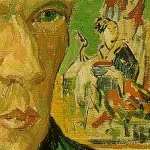

My trip to France last summer was intended to continue my Van Gogh education, and so this determined/limited exactly where I went, how I spent my time. This was especially true for Paris, as I had only two days in the city--in fact, less than that, given that one of those days included the day I arrived (rather early) into de Gaulle airport and took the train into the city, where I stumbled around the vicinity of Notre Dame before getting my bearings and finding my hotel. Half of my second day there wasn't actually spent in Paris at all, but Asniéres, a place I'd known for months I wanted to see. Asniéres is community--a small city really--just past the northwest edge of Paris. It's relevant to Van Gogh because it is where the painter Emile Bernard, who Van Gogh first met in a Paris art school run by Fernand Cormon, lived with his parents when Bernard was still a young, arrogant, phenom, not yet trapped under the boot heel of Gauguin, as he would be later. One can walk from Asniéres to Montmartre, and I assume that this is what the young Bernard did to get to Cormon's school. And, of course, the reverse is true too: one can walk from Montmartre to Asniéres, which Van Gogh did regularly, in search of subjects and company. (And I suspect, too, to just get out of the city.) He painted in Asniéres not only with Bernard but Paul Signac, creating among other things several renditions of the Pont de Clichy, the bridge that crosses the Seine shortly before one gets to Asniéres.
In Van Gogh's time, Asniéres was regarded as an unfashionable, working class area. To paint there was to make a statement as to where one's fealty lay. It's not surprising at all that Van Gogh--Bernard or no Bernard--would decide to walk away from Montmartre to see where the real people lived. Before I started seriously looking at maps and seriously planning my trip, I imagined I might have to take a bus to Asniéres or maybe even a train. Or simply pay a hefty fare to some Paris cabbie. I wasn't staying in the northwest corner of the city but in center Paris, on the left bank. I was pleasantly surprised when I realized I could take the Paris Metro to Asniéres. Asniéres, it turned out, was the last stop on the 13 line. I actually got off one stop before then, so that I could cross the Pont de Clichy on foot and find a place to settle in there on the bank of the Siene. Whenever I can, on these trips to France, if I am near a place where Van Gogh worked, I try to find the specific location, a duplication of the view he had, so I can see and feel for myself what it is like to be there. Exactly there.
It was a beautiful, clear, sunny Sunday morning and I felt enormously relieved to just be out, in France, after those months of planning and days (it felt like) of traveling. I crossed the bridge, noticing, even a hundred years later, an energy to the area and the outline, in the near distance, of what looked like shiny apartment and office buildings. So that is where people really work, I thought, not just visit. On the other side, I found a stairway leading down, and then at the bottom, a wide walkway on the side of the river that went on for as long as I could see in both directions. In front of me was the Seine, behind me a grassy hill. I lumbered along for a while, until I found a spot with a bench that gave me a view approximating Van Gogh's. A group of guys, carrying several evident bottles of beer, were lingering harmlessly on a dock nearby; dozens of joggers passed on the walkway as well as dog walkers and parents with young kids in strollers. It was a Sunday. It was sunny. It was early May. The French were out. I settled in, pulled out a sketchpad and colored pencils and spent a glorious hour there by the river, watching the play of light on the water, the texture of the currents, the shape of trees on the other bank, the skyline beyond the top of the bridge. I drew and observed and drew and observed, soaking in the sunshine, trying to remove a hundred + years. Trying to feel myself in the nineteenth century.













0 comments:
Post a Comment